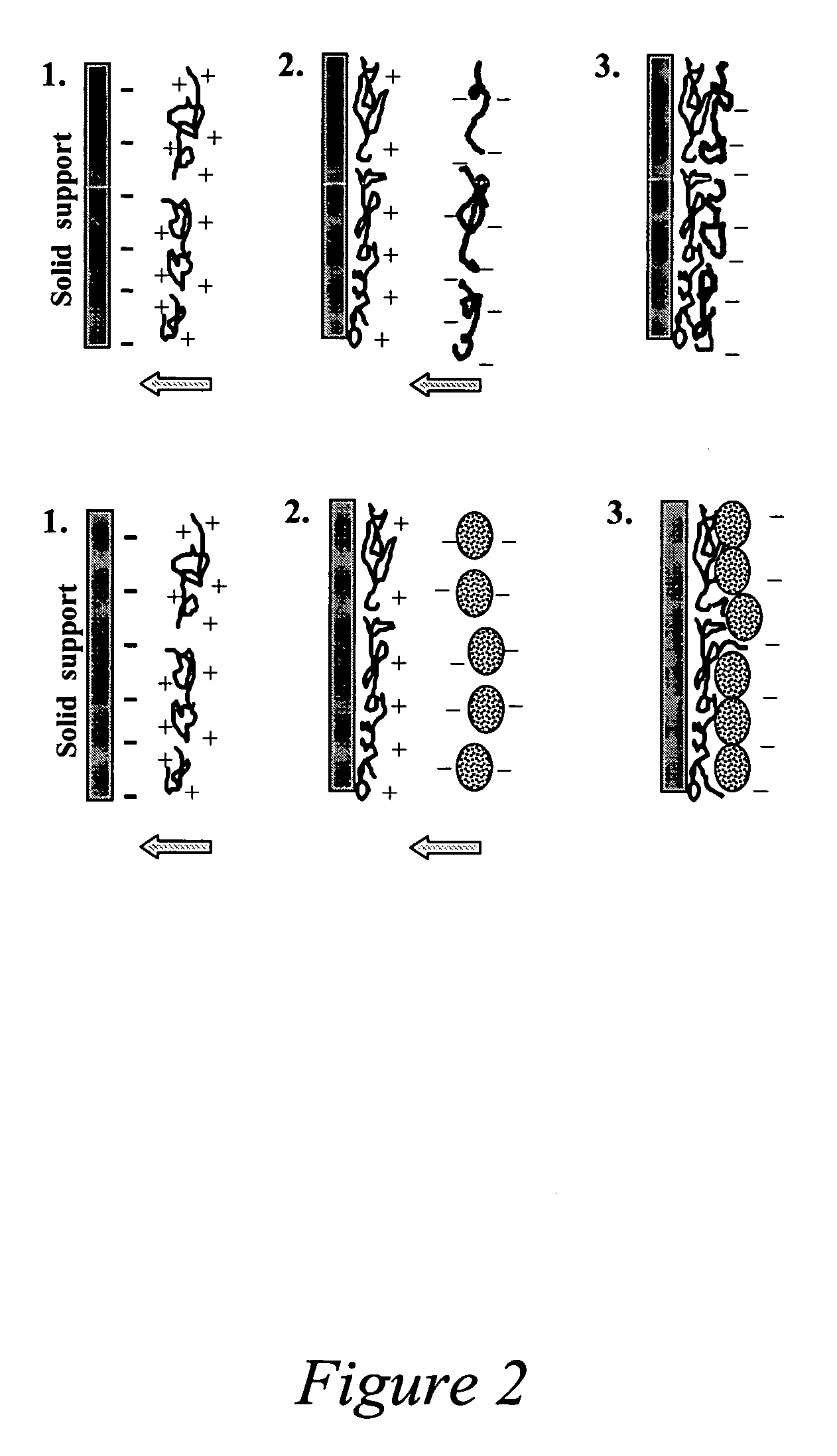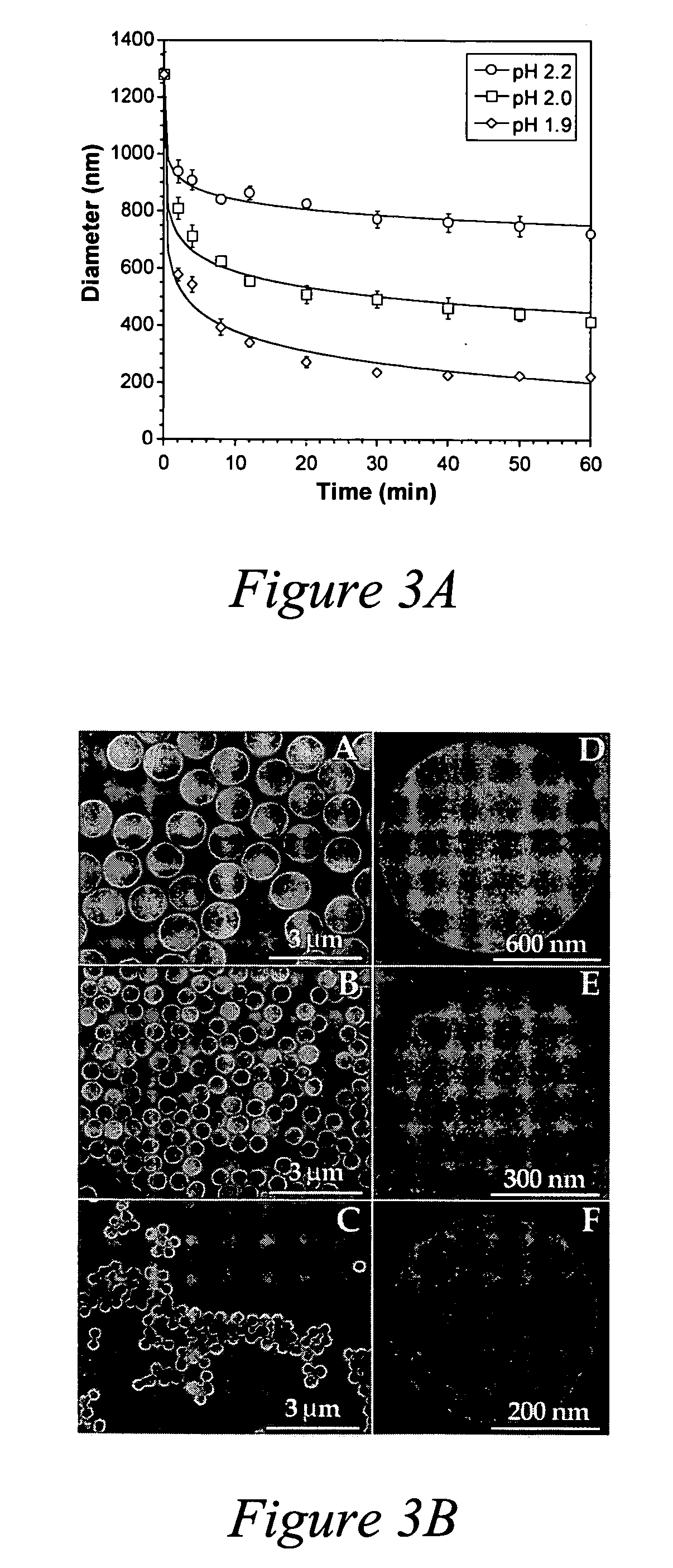Drug delivery system based on polymer nanoshells
a delivery system and nano-shell technology, applied in the field of microcapsules, can solve the problems of intrinsic limitations of existing delivery systems, lack of controlled release of drugs from liposome formulations, and limited success in the development of drug carriers, and achieve the effect of effective targeting cancer cells and non-invasive monitoring of cell targeting efficiency
- Summary
- Abstract
- Description
- Claims
- Application Information
AI Technical Summary
Benefits of technology
Problems solved by technology
Method used
Image
Examples
example i
[0100] In drug delivery applications, smaller particle diameter (<1 μm) is important for prolonged blood circulation and enhanced drug targeting to specific body sites. The size of a self-assembled polymer shell directly correlates with the core size. In this example, monodisperse, decomposable MF particles ranging from 1 to 5 μm in diameter, obtained from Microparticles GmbH (Berlin, Germany), were the source of the cores.
[0101] In order to further reduce the particle size, the particles were subjected to a surface-erosion procedure. It has been reported that complete MF particle decomposition occurs after 20 seconds in a pH 1.1 HCl solution (C. Gao et al., Macromol. Mater. Eng. 286 (2001) 355). Applicants have discovered that at higher pH values (>1.9), MF particle size is gradually reduced through surface degradation. By way of example, monodisperse 1.2 μm MF particles (Microparticles GmbH, Germany) were suspended in acidic HCl solutions (6×105 particles / ml) with a specific pH v...
example ii
[0129] Cationic poly(dimethyldiallyl ammonium chloride) (PDDA, MW 200 KD, Aldrich), and negatively charged polypeptide, gelatin (Sigma) were selected for the LbL assembly. Solutions of 2 mg / mL PDDA, and 3 mg / mL gelatin were prepared in phosphate buffered saline (PBS). 1,2-Dipalmitoyl-sn-Glycero-3-Phosphocholine (DPPC), 1,2-Dipalmitoyl-sn-Glycero-3-Phosphate (DPPA), and NBD labeled DPPC were obtained from Avanti Polar Lipids, Inc. 2 mg / mL Doxorubicin (DOX) HCl (Bedford Laboratories™, Bedford, Ohio) was preserved in a 0.9% sodium chloride pH 3 solution. 50-nm silica particles were obtained from Polysciences, Inc. Weakly crosslinked Melamine formaldehyde (MF) particles, 5 micron in diameter, was obtained from Microparticles GmbH, Germany. Human breast cancer MCF-7 cells were obtained from ATCC.
[0130] The shell fabrication procedure is illustrated in FIG. 10. MF microparticles were used as templates and incubated in gelatin solution. 50 minutes of coating was performed before washing a...
example iii
[0141] Cationic polymers used include poly(dimethyldiallyl ammonium chloride) (PDDA, MW 200 kD, Aldrich), poly(ethyleneimine) (PEI, MW 25 kD, Aldrich; MW 1.2 kD, Polysciences, Inc.), poly(allylamine) hydrochloride (PAH, MW 10 kD, Aldrich), and poly-L-lysine (PLL, MW 30 kD, Sigma). Negatively charged materials, including bovine albumin (MW 66kD, Sigma), gelatin (MW 50 kD-100 kD, Sigma), and poly(styrenesulfonate) (PSS, MW 70 KD, Aldrich), were selected for the LbL self-assembly. 1,2-Dipalmitoyl-sn-glycero-3-phosphocholine (DPPC) and 1,2-Dipalmitoyl-sn-glycero-3-phosphate (DPPA) (Avanti Polar Lipids, Inc) were prepared to form negatively charged liposomes. Copolymers PEI poly(ethyleneimine) 25K-poly(ethylene glycol) 5K (PEI-PEG) (1:1, 1:5, and 1:10) were synthesized and used for coating the outermost layer. Negatively charged 50 nm Fluoresbrite® YG Carboxylate nanoparticles (Polysciences, Inc) were used as a fluorescent label in the polymer multilayers for the polyelectrolyte shells. ...
PUM
| Property | Measurement | Unit |
|---|---|---|
| Diameter | aaaaa | aaaaa |
| Diameter | aaaaa | aaaaa |
| Diameter | aaaaa | aaaaa |
Abstract
Description
Claims
Application Information
 Login to View More
Login to View More - R&D
- Intellectual Property
- Life Sciences
- Materials
- Tech Scout
- Unparalleled Data Quality
- Higher Quality Content
- 60% Fewer Hallucinations
Browse by: Latest US Patents, China's latest patents, Technical Efficacy Thesaurus, Application Domain, Technology Topic, Popular Technical Reports.
© 2025 PatSnap. All rights reserved.Legal|Privacy policy|Modern Slavery Act Transparency Statement|Sitemap|About US| Contact US: help@patsnap.com



